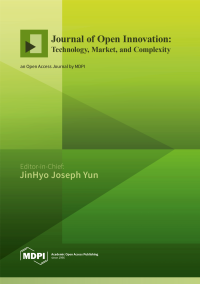Open Innovation in Startups: Competitive Strategies for Differentiation
A special issue of Journal of Open Innovation: Technology, Market, and Complexity (ISSN 2199-8531).
Deadline for manuscript submissions: closed (12 December 2022) | Viewed by 43596
Special Issue Editors
Interests: health communication; open innovation; tourism communication; communication and social media; influencers on social media; institutional communication; stakeholder engagement
Interests: entrepreneurship; startups; open Innovation; women-led companies; entrepreneurial Intention
Special Issue Information
Dear Colleagues,
The adoption of the open innovation paradigm implies opening the company to external sources as a key to competitiveness. Maintaining active communication channels with different stakeholders—customers, other companies, universities, research institutes, etc.—offers particularly significant benefits for any type of company. The combination of internal and external intelligence has led Chesbrough (2003) to study this concept since it was first introduced in the field of boundaries and networks management. However, the literature has associated this philosophy with companies characterized by their activities in changing environments, with high levels of technology and/or disruptive products, and which constantly make decisions in uncertain environments. In particular, start-ups seem to be connected to this philosophy as a direct consequence of their own reality. In any case, even today there is still a need for further development in this line, both because of the details involved in its implementation in this type of company and because of the lack of evidence on what performance can be directly attributed to open innovation.
Finally, going one step further, the internalization of this paradigm may be conditioned by the management style, and the proactivity that characterizes the business-promoting team, but so far, there is little research that also introduces variables such as gender, communication, or greater familiarity with digital environments as support tools to favour co-creation with stakeholders. Consequently, this Special Issue will focus on the management of their relationships with different stakeholders, and the contribution and effects this has on their differentiation strategies from different points of view: the definition of the business model, level of innovation, communication, reputation, etc.
Dr. Carlos de las Heras-Pedrosa
Dr. Patricia P. Iglesias-Sánchez
Dr. Carmen Jambrino-Maldonado
Guest Editors
Manuscript Submission Information
Manuscripts should be submitted online at www.mdpi.com by registering and logging in to this website. Once you are registered, click here to go to the submission form. Manuscripts can be submitted until the deadline. All submissions that pass pre-check are peer-reviewed. Accepted papers will be published continuously in the journal (as soon as accepted) and will be listed together on the special issue website. Research articles, review articles as well as short communications are invited. For planned papers, a title and short abstract (about 100 words) can be sent to the Editorial Office for announcement on this website.
Submitted manuscripts should not have been published previously, nor be under consideration for publication elsewhere (except conference proceedings papers). All manuscripts are thoroughly refereed through a single-blind peer-review process. A guide for authors and other relevant information for submission of manuscripts is available on the Instructions for Authors page. Journal of Open Innovation: Technology, Market, and Complexity is an international peer-reviewed open access quarterly journal published by MDPI.
Please visit the Instructions for Authors page before submitting a manuscript. The Article Processing Charge (APC) for publication in this open access journal is 800 CHF (Swiss Francs). Submitted papers should be well formatted and use good English. Authors may use MDPI's English editing service prior to publication or during author revisions.
Keywords
- open innovation
- stakeholder management
- managed by women
- open communication in startups
- digital environment
- empowerment
- sustainability
Benefits of Publishing in a Special Issue
- Ease of navigation: Grouping papers by topic helps scholars navigate broad scope journals more efficiently.
- Greater discoverability: Special Issues support the reach and impact of scientific research. Articles in Special Issues are more discoverable and cited more frequently.
- Expansion of research network: Special Issues facilitate connections among authors, fostering scientific collaborations.
- External promotion: Articles in Special Issues are often promoted through the journal's social media, increasing their visibility.
- e-Book format: Special Issues with more than 10 articles can be published as dedicated e-books, ensuring wide and rapid dissemination.
Further information on MDPI's Special Issue polices can be found here.






